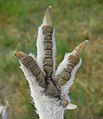Bird feet facts for kids

Bird feet are amazing! They are perfectly adapted to the way each bird lives. These special feet help scientists classify different bird types.
All birds, like us, have limbs that came from ancient animals called tetrapods. These early animals had five fingers and five toes. Birds, however, have no more than four toes. They inherited this from their dinosaur ancestors, the theropods. These four toes are arranged in four main ways.
How Bird Toes Are Arranged
Anisodactyly: Three Forward, One Back
This is the most common toe arrangement in birds. It means three toes point forward, and one points backward. You'll see this in many passerine birds, especially songbirds. It's also found in hunting birds like eagles, hawks, and falcons.
The anisodactyl arrangement helps passerine birds perch on tree branches or cliffs. The back toe joins the leg at the same level as the front toes.
Passerine birds have a special trick for perching. It's called a tendon-locking mechanism. A tendon in the back of their leg automatically tightens when the leg bends. This makes the foot curl tightly around a branch. Another tendon locks it in place. This means songbirds can sleep while perching without falling off! Some passerines also have stiff tail feathers. These help them balance when they perch on vertical surfaces.
Syndactyly: Toes Fused Together
Syndactyly is similar to anisodactyly. The difference is that two or three toes are joined together. This is common in birds like kingfishers, bee-eaters, and rollers.
Zygodactyly: Two Forward, Two Back
In this arrangement, two toes face forward (the second and third toes). The other two toes face backward (the first and fourth toes). This is very common in birds that live in trees. It's especially helpful for birds that climb tree trunks or move through leaves.
You can see zygodactyly in parrots, woodpeckers, cuckoos (like roadrunners), and some owls. Scientists have found tracks of zygodactyl feet from 120 to 110 million years ago! That's 50 million years before the first fossil of a zygodactyl bird was found.
Heterodactyly: A Rare Arrangement
Heterodactyly is like zygodactyly, but with a twist. The third and fourth toes point forward, and the first and second toes point back. This unique arrangement is only found in trogons.
Pamprodactyly: All Toes Can Point Forward
With pamprodactyly, all four toes can point forward. Birds can also rotate the outer two toes backward if they need to. This is a special feature of swifts.
Didactyly: Only Two Toes
The ostrich is the only bird with just two toes on each foot. The nail on its larger, inner toe looks like a hoof. The outer toe has no nail. Having fewer toes is an adaptation that helps ostriches live on open land. They can run over 70 miles per hour (70 km/h) and cover 3 to 5 meters (10 to 16 ft) in a single stride!
Parts of a Bird's Leg
The Hidden Knee Joint
A bird's knee joint points forward, just like ours. It's located between the femur bone and the tibia (or tibiotarsus). But you usually can't see it because it's hidden by feathers. What looks like a backward-pointing "heel" or ankle is actually a joint between the tibiotarsus and another bone called the tarsometatarsus.
Tarsometatarsus: An Extra Leg Segment
The tarsometatarsus is the third part of a bird's leg. Only birds have this bone! It developed from ankle bones in their ancestors. The tarsometatarsus makes the leg longer, giving birds extra leverage. This helps them run, jump, or perch.
Bird Scales
Bird scales are made of keratin. This is the same material that makes up their beaks, claws, and spurs. You'll find scales on their toes and sometimes higher up on their ankles. Scientists believe bird scales are similar to the scales found on reptiles. In fact, feathers are thought to have grown from the scales of ancient archosaurs, which were reptile-like animals.
Images for kids
-
African jacana. Extremely long toes and claws help distribute the jacana's weight over a wide area to allow it to walk on floating leaves.
-
Chick of Pelargopsis capensis with heel-pads
-
The ostrich is the only bird that has the didactyl foot.
-
Grey parrot grips the perch with zygodactyl feet.
-
Palmate feet – Chilean flamingo.
-
Totipalmate feet – blue-footed booby.
-
Western grebe presenting a lobate foot.
-
Lobate feet – a chick of the Eurasian coot.
-
The great crested grebe. The feet in loons and grebes are placed far at the rear of the body - a powerful accommodation to swimming underwater, but a handicap for walking.
-
The snowshoe-like foot of the willow ptarmigan is an adaptation for walking on snow.












